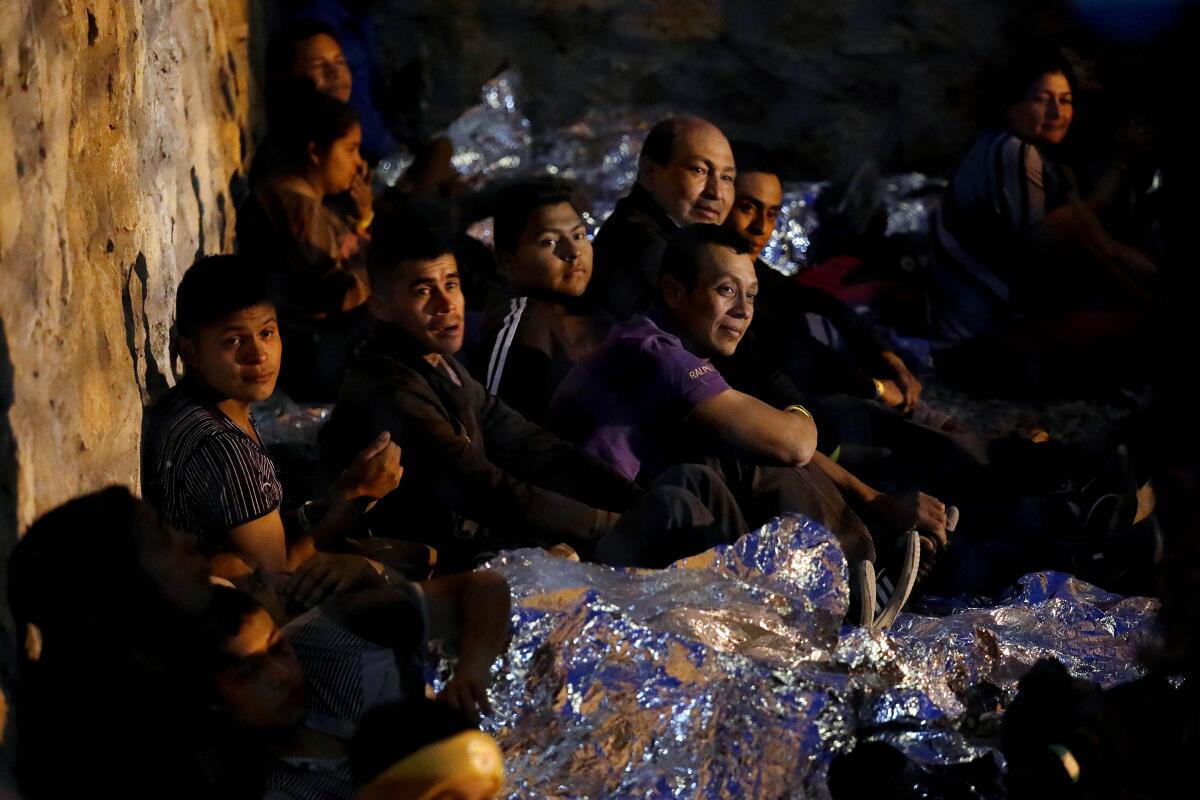Mexico balks at U.S. plan to send Mexican asylum seekers to Guatemala

- Share via
MEXICO CITY — Mexico is voicing opposition to the Trump administration’s controversial plan to send Mexicans seeking asylum in the United States to Guatemala instead.
“It’s a decision that worries us and a decision that we cannot agree with,” the Mexican ambassador to the United States, Martha Barcena, said Tuesday. “This decision was not consulted with us. It is a decision they made with Guatemala.”
According to internal U.S. Citizenship and Immigration Services documents obtained by The Times, the Trump administration holds that Mexicans are not excluded from an agreement it reached in July for Guatemala to take asylum seekers who are not Guatemalan.
Ashley Caudill-Mirillo, deputy chief of the asylum division at U.S. Citizenship and Immigration Services, wrote to the field offices on Jan. 4, saying the inclusion of Mexicans in the Guatemala agreement was “effective immediately.”
“Mexican nationals are now included in the amenable population for purposes of the Guatemalan ACA,” she wrote, using an acronym for the Guatemala deal, formally known as the Asylum Cooperative Agreement.
The U.S. Department of Homeland Security did not respond to requests for comment on whether Trump administration officials consulted Mexico before issuing the directive regarding its citizens. Mexican President Andrés Manuel López Obrador, when asked about the issue at his morning news conference on Tuesday, said he had “no information” on the matter.
There also appeared to be confusion over the policy in Guatemala. Alejandra Mena, a spokeswoman with the government’s immigration institute, said that while there have been “conversations on the issue” of Mexican asylum seekers, the “agreement involves the transfer of Hondurans and Salvadorans only.”
The policy in effect blocks Mexicans — and any asylum seeker arriving at the U.S.-Mexico border who is not Guatemalan — from seeking protection in the United States, sending them more than 1,000 miles south instead.
The United States has yet to expel any Mexican asylum seekers to Guatemala, but the new U.S. policy could soon affect about 900 Mexican asylum seekers, the Mexican Foreign Secretariat said in a statement late Monday signaling its “disagreement.”
Mexican authorities “will work to offer better options to the Mexicans who could be affected,” the statement said, without providing details.
On Tuesday in a tent camp of thousands of asylum seekers in the Mexican border city of Matamoros, Manuela Morales fretted that she and her two sons, all Mexican citizens who’d waited for two months to claim asylum in the United States, may now be sent to Guatemala instead.
“Imagine if they send us there,” said 37-year-old Morales, who came from southern Mexican state of Chiapas and expressed fear that gangs in Guatemala would target her for being Mexican. “We’ll be killed directly.”
The U.S. began implementing the agreement with Guatemala in November and so far has applied it only to people from Honduras and El Salvador, according to Mena, the Guatemalan official. It has flown 97 asylum seekers to Guatemala City, including 45 on Monday and Tuesday.
Of those, six initially opted to pursue asylum in Guatemala, but five have since abandoned their claims.
Similar agreements with El Salvador and Honduras are part of a broader effort by the U.S. government to essentially end asylum claims at the U.S. southern border. President Trump and his top aides view most asylum seekers arriving at the border as economic migrants intent on abusing immigration laws to gain entry to the United States.
Migrant advocates, academics and officials in the United States, Mexico and Guatemala, meanwhile, have denounced the policy. By law, migrants arriving at the border have a right to claim asylum in the United States.
Guatemala, as well as its Central American neighbors, has negligible infrastructure to handle asylum applications — despite assurances issued by U.S. Citizenship and Immigration Services that the acting secretary of Homeland Security and the attorney general have certified that asylum seekers returned to Guatemala under the agreement “would have access to a full and fair procedure for determining their claims for protection.”
The number of people from Guatemala, Honduras and El Salvador arriving at the U.S. border reached a decade-long high in May but has declined precipitously in recent months as Mexico, under U.S. pressure, has cracked down on their travel through Mexican territory.
The Trump administration also attributes the drop to the so-called Remain in Mexico policy, under which more than 50,000 asylum seekers, mostly Central Americans, have been sent back to Mexico since last year to await the outcome of U.S. asylum claims, a process that can drag on for months. Word has circulated that asylum petitioners face long waits in Mexico, discouraging potential migrants from making the journey and prompting others to abandon their hopes for asylum and return home.
At the same time, Homeland Security officials have been alarmed by a steep rise in the number of Mexicans trying to enter the United States. In October and November, nearly 13,000 Mexicans came to U.S. ports of entry, compared with just over 1,000 for the three Central American countries, according to Customs and Border Protection data.
Thousands of Mexicans have lined up to file asylum claims in the United States. Many are from violence-racked Mexican states such as Guerrero and Michoacán, or from the southern state of Chiapas, where conflicts about land and religion have long sparked violence and forced displacements of communities.
Mexican asylum seekers have been one of the last remaining groups with a path to protection in the United States, because U.S. and international laws broadly bar asylum seekers from being forcibly returned to the countries from which they are fleeing.
In December, the acting deputy Homeland Security secretary, Ken Cuccinelli, tweeted that U.S. officials were considering removing Mexican nationals seeking asylum to Guatemala. U.S. authorities had initially characterized the deal with Guatemala as focused on Central Americans, and Guatemalan representatives said when the pact was signed that it would apply only to Hondurans and Salvadorans.
U.S. officials also said the agreement with Guatemala would roll out slowly, beginning with a “pilot program” in El Paso and limited at first to single adults. But on Dec. 10, they quietly started pushing Central American families seeking asylum in the United States to Guatemala for the first time.
And even if rejected for asylum in Guatemala, applicants do not get another chance in the U.S. Once removed, they can be barred from reentering the United States for five years or longer, according to the Citizenship and Immigration Services guidance.
In Matamoros, Morales and two friends, fellow asylum seekers from across Mexico, said they planned to wait at the border camp and hope that the Trump administration’s latest policy wouldn’t be applied to them.
“It’s better for us to die here...,” said Rocio Bautista, 29.
Morales added, “... In our Mexico.”
McDonnell reported from Mexico City and O’Toole from Washington. Times staff writers Cindy Carcamo in Los Angeles, Molly Hennessy-Fiske in Matamoros and Cecilia Sánchez of The Times’ Mexico City bureau contributed to this report.
More to Read
Sign up for Essential California
The most important California stories and recommendations in your inbox every morning.
You may occasionally receive promotional content from the Los Angeles Times.














